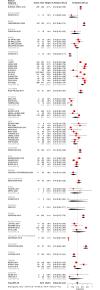ELBW and ELGAN outcomes in developing nations-Systematic review and meta-analysis
- PMID: 34352883
- PMCID: PMC8342042
- DOI: 10.1371/journal.pone.0255352
ELBW and ELGAN outcomes in developing nations-Systematic review and meta-analysis
Abstract
Context: Morbidity and mortality amongst extremely low birth weight (ELBW) and extremely low gestational age neonates (ELGANs) in developing nations has not been well studied.
Objectives: Evaluate survival until discharge, short- and long-term morbidities of ELBW and ELGANs in LMICs.
Data sources: CENTRAL, EMBASE, MEDLINE and Web of Science.
Study selection: Prospective and retrospective observational studies were included.
Data extraction and synthesis: Four authors extracted data independently. Random-effects meta-analysis of proportions was used to synthesize data, modified QUIPS scale to evaluate quality of studies and GRADE approach to ascertain the certainty of evidence (CoE).
Results: 192 studies enrolling 22,278 ELBW and 18,338 ELGANs were included. Survival was 34% (95% CI: 31% - 37%) (CoE-low) for ELBW and 39% (34% - 44%) (CoE-moderate) for ELGANs. For ELBW neonates, the survival for low-income (LI), lower middle-income (LMI) and upper middle income (UMI) countries was 18% (11% - 28%), 28% (21% - 35%) and 39% (36% - 42%), respectively. For ELGANs, it was 13% (8% - 20%) for LI, 28% (21% - 36%) for LMI and 48% (42% - 53%) for UMI countries. There was no difference in survival between two epochs: 2000-2009 and 2010-2020. Except for necrotising enterocolitis [ELBW and ELGANs-8% (7% - 10%)] and periventricular leukomalacia [ELBW-7% (4% - 11%); ELGANs-6% (5%-7%)], rates of all other morbidities were higher compared to developed nations. Rates of neurodevelopmental impairment was 17% (7% - 34%) in ELBW neonates and 29% (23% - 37%) in ELGANs.
Limitations: CoE was very low to low for all secondary outcomes.
Conclusions: Mortality and morbidity amongst ELBW and ELGANs is still a significant burden in LMICs. CoE was very low to low for all the secondary outcomes, emphasizing the need for high quality prospective cohort studies.
Trial registration: PROSPERO (CRD42020222873).
Conflict of interest statement
The authors have declared that no competing interests exist.
Figures
References
-
- WHO, March of Dimes, PMNCH, Save the Children. 15 million preterm births: Priorities for action based on national, regional and global estimates. In: Howson CP, Kinney MV, Lawn J, eds. Born Too Soon: The Global Action Report on Preterm Birth. 2012.
-
- WHO, Every Newborn: an action plan to end preventable deaths. 2014 https://www.who.int/maternal_child_adolescent/documents/every-newborn-ac... Accessed 10th January 2021.
Publication types
MeSH terms
LinkOut - more resources
Full Text Sources
Medical




